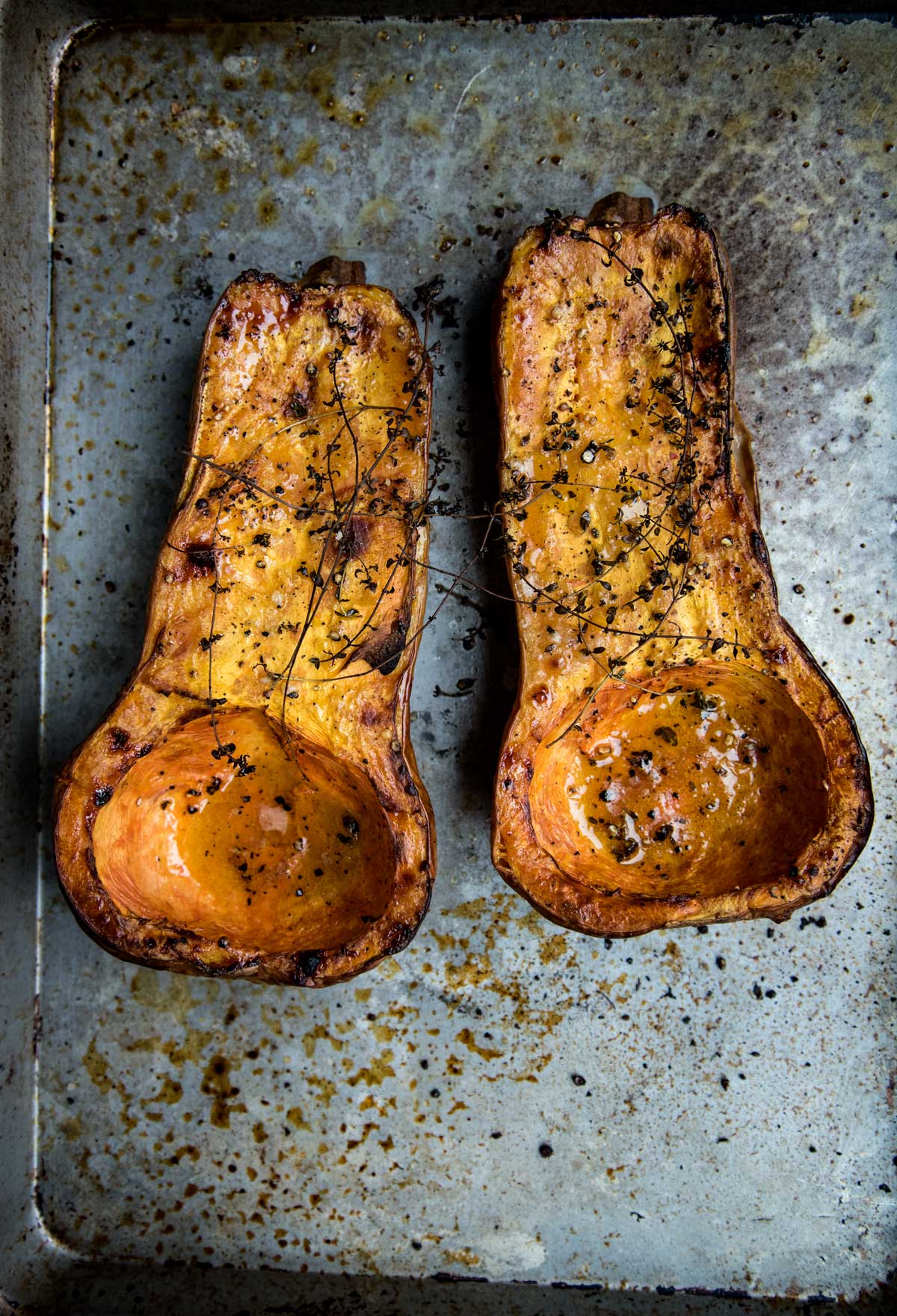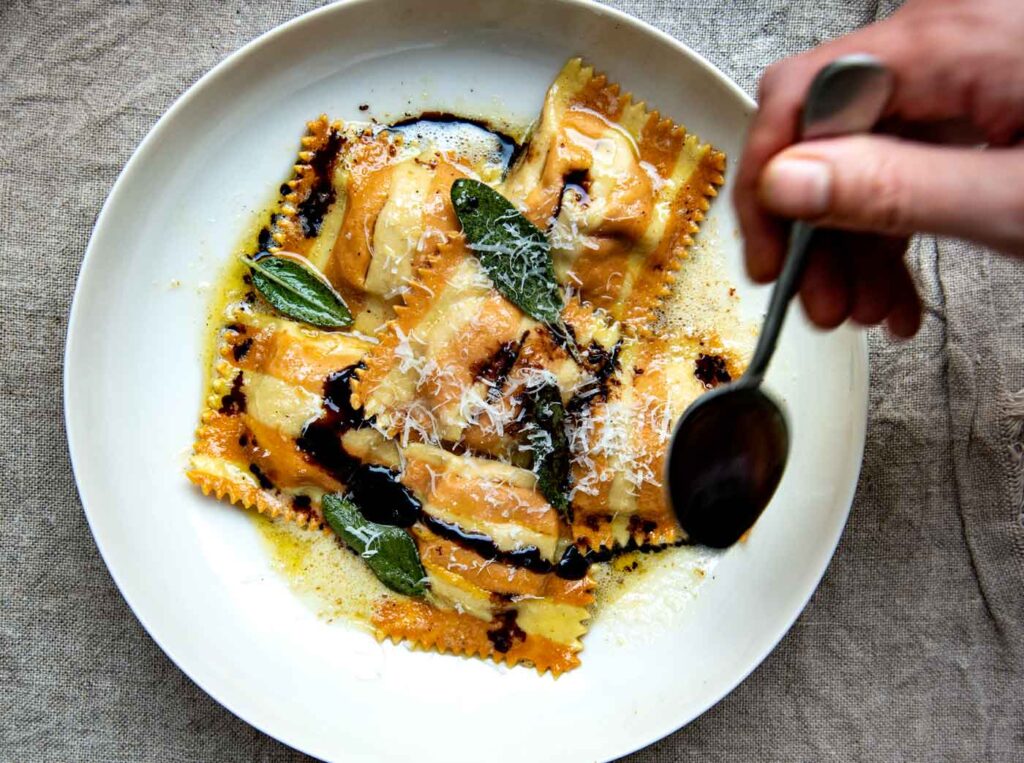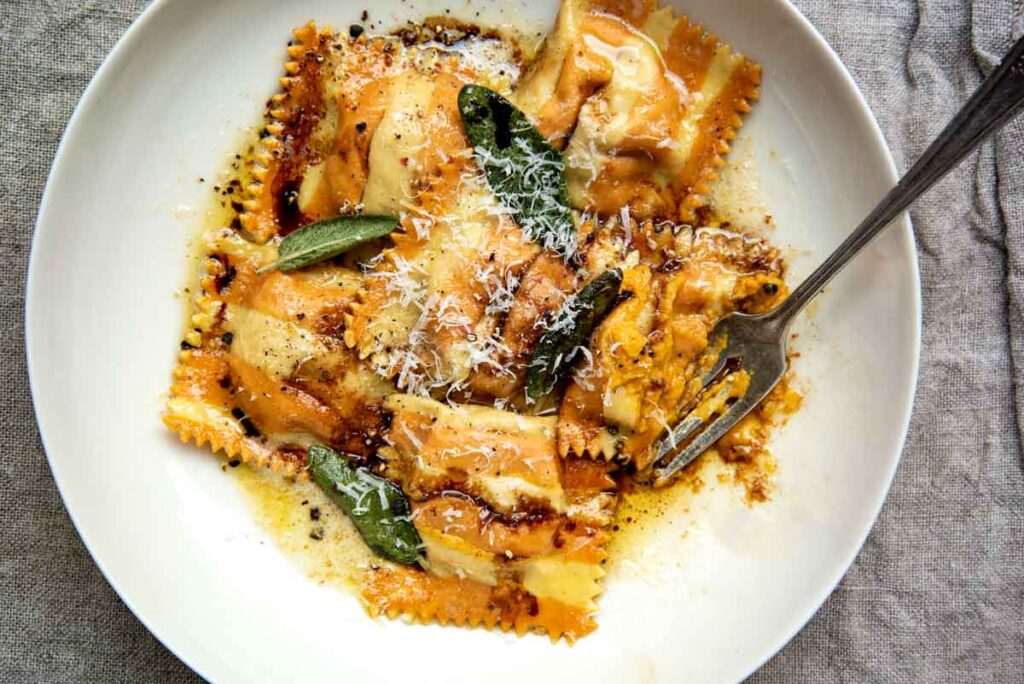
It’s pumpkin/winter squash season, so I went with a simple filling of roasted butternut squash, shallot, ricotta, Parmesan, and nutmeg. I made the ravioli extra plump, but you can of course make them as big or small as you like. I piped the filling with a piping bag, which makes the process much easier. If I had to eyeball I would say at least a tablespoon and a half of filling, give or take.
As for the finished dish…after a brief dip in a pot of salted boiling water, I bathed the butternut squash ravioli in a little melted/brown butter, a splash of pasta cooking water, and a grating of Parmesan cheese in a hot pan. Transferred to a serving plate and topped with some crispy sage leaves, a splash of good quality aged balsamic vinegar, a little more Parmesan, and a fresh grind of black pepper.
The butternut squash ravioli can be frozen so that you can have them whenever you want. Just sprinkle a sheet pan with some semolina to prevent them from sticking, lay them in a single layer, and freeze. Once they’re frozen, you can pop them into a zip-lock bag or air-tight container. They can go straight from the freezer into a pot of boiling, salted water.



Butternut Squash Ravioli
Instructions
- Lightly flour your work surface. Cut off 1/4 to 1/3 of the dough, keeping the rest covered in plastic so it doesn’t dry out. Run the dough through your pasta machine starting with the largest setting. Run it two to three times through each successive pasta roller setting until about 1/16th-inch thick (third to the last setting — #6 on my KitchenAid pasta attachment). Lay the sheet of pasta on a lightly floured work surface to prevent the dough from sticking.
- I made these ravioli extra large. Pipe a generous amount of filling (approximately 1 1/2 tablespoons) along the length of the sheet, leaving an inch or so between each. Fold the dough over lengthwise. With the side of your hand, squeeze out any excess air in between each mound of filling. With a fluted cutter, cut along the length of the pasta dough. Then cut into individual ravioli. As for the size of each stuffed pasta, I eye-balled it, but if I had to give a more exact measurement, I would say roughly 2 1/2 inch squares. Place ravioli on a baking sheet dusted with semolina in a single layer. Repeat with the remaining pasta and filling.
- To Finish the Dish: Bring a pot of water to a boil. Salt the water. When it comes back to a boil, drop in the pasta (working in batches, a dozen or so at a time). Cook until 80% cooked through, about two minutes.Meanwhile, heat a skillet over medium heat. Melt a couple tablespoons of butter. Add a tablespoon or two of pasta water and swirl. Add some freshly grated Parmesan. With a slotted spoon transfer the ravioli to the skillet and gently toss the pasta in the butter. Cook another minute or two until al dente. With a slotted spoon, transfer to serving plates. Spoon a little hot butter on top. Top with crispy sage leaves. Drizzle with balsamic vinegar and a few grinds of black pepper. Serve immediately.
- Leftover ravioli can be frozen. Place baking sheet with leftover ravioli in the freezer. Once frozen, transfer to zip-lock bag or air-tight container.
- * To crisp up the sage leaves: heat a little olive oil in a small skillet. When sizzling hot, add a small handful of sage leaves and cook until crispy, a few minutes. Place on paper towels to drain.
Notes
Pasta Dough
Ingredients
- 200 grams 00 flour (more or less as needed)
- 2 whole eggs
- 2 yolks
- Pinch salt, optional
Instructions
- Mix the flour (and salt, if using). Place the flour on a dry, clean work surface and form it into a mound. Create a large shallow well in the middle, making sure the walls are high enough to prevent the eggs from escaping.Crack the eggs into the well. With a fork, beat the eggs; be careful not to disturb the walls of the flour.
- Once the eggs are well beaten, begin to incorporate the flour walls into the egg mixture. Continue incorporating the flour with the eggs with your fork until you have a shaggy, solid mass. At this point, using your hands, start folding and forming the dough, incorporating the rest of the flour until you have a stiff, solid mass (removing any dry clumps of flour).Knead the dough. Drive the palms of your hand into the dough, pushing the dough forward. Continue, rotating the dough and folding the dough over its self, which helps to incorporate air pockets into the dough. Repeat until the dough is firm and bouncy and has a smooth, silken texture, about 10 minutes.
- Wrap the dough in plastic and let rest 30 minutes.
Notes
Butternut Squash Filling
Ingredients
- 2 1/2 pound butternut squash
- extra virgin olive oil
- salt and pepper
- few sprigs fresh thyme
- 1/3 cup minced shallot
- 1 tbsp butter
- 1/2 cup loosely packed, freshly grated Parmesan
- 1/2 cup fresh ricotta, drained if necessary
- freshly grated nutmeg
Instructions
- To roast the butternut squash: Preheat the oven to 425F. Slice the squash in half lengthwise. Scoop out the seeds. Place the squash, cut side up, on a sheet pan, drizzle with olive oil, and season with salt and pepper. Place a few sprigs of thyme on top. Roast until the squash is fork tender, 50 to 60 minutes. Let cool. Scoop out the flesh and place in a food processor. Discard its skin.
- Heat the butter in a skillet. Add the shallot and sauté until soft and golden brown, about 5-7 minutes.
- Add the shallot to the food processor, along with the Parmesan and ricotta. Add a few gratings of nutmeg. Season with salt and pepper. Pulse until well combined. Transfer mixture to a piping bag.

